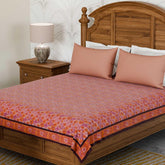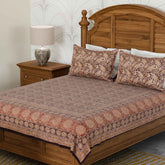Comforter vs Blanket: Which One Is Right for You?

Do you often wake up at night feeling too cold or too hot? The type of bedding you choose might be the reason for that. It plays a key role in your sleep quality, mood, daily comfort, and overall well-being.
When shopping for bed linen, many people get confused by the various options available, including comforters, bed covers, duvets, and quilts. These bedding essentials help you stay warm, but they are built differently and serve unique purposes depending on the weather, your body temperature, and personal preferences.
In this blog, we will explain the difference between a comforter and a blanket and compare their advantages and disadvantages. We will also share versatile options perfect for every season, helping you choose what’s best for a good night’s sleep.
Quick Summary
Here’s a quick comparison to understand the fundamental difference between a comforter and a blanket:
|
Features |
Comforter |
Blanket |
|
Construction |
Multi-layered with insulating fill; thick and fluffy. |
Single layer, usually flat, lightweight. |
|
Warmth |
High |
Mild to moderate |
|
Breathability |
Less breathable (if they contain synthetic materials) |
Breathable (if made of natural fibre) |
|
Care |
Dry clean or gentle machine wash |
Easy to wash |
|
Comfort |
Comfortable and warm; well protected in colder conditions |
Comfortable without overheating |
|
Style |
Decorative appeal |
Simpler look |
|
Storage |
Bulky and needs more space |
Compact and easy to fold |
|
Versatility |
Limited |
Versatile |
|
Usage |
Best for cold seasons or AC rooms; can be used standalone |
Suitable for all seasons; can be layered |
|
Price |
Expensive |
Budget-friendly |
|
Best For |
Those who feel too cold easily |
Those who prefer breathable, lighter layers |
Comforter vs Blanket: What’s the Real Difference and Which One Should You Use?
A blanket typically consists of a single layer of wool, cotton, or fleece. Its weight determines whether it suits summer, winter, or year-round use. On the other hand, a comforter is multi-layered and often filled with synthetic fibres, making it fluffy and warm.
These structural differences affect everything—from warmth and breathability to care, price, and usage.
1. Warmth and Insulation

 Comforter:
Comforter:
-
Ideal for winter or air-conditioned rooms.
-
Retains body heat and provides maximum warmth.
-
They may be too bulky for toddlers or elderly individuals.
Blanket:
-
Works well in summer or moderate climates.
-
Provides a gentle layer of warmth.
-
They are lightweight and easy to handle, making them suitable for children and older adults.
Tip: Choose a comforter if you tend to feel cold at night. If you get warm or sweat easily, use a light blanket instead.
2. Breathability and Fabric Type

Blankets:
-
Made from breathable materials like cotton, bamboo fibre, or wool
-
Help regulate body temperature and improve air circulation.
Comforters:
-
Typically made of polyester blends that trap more heat.
-
Less breathable, especially in warm or humid weather.
Tip:
-
Opt for breathable blankets in hot or humid conditions.
-
Choose a comforter with a cotton cover for added luxury and breathability.
3. Maintenance and Cleaning
Blankets:
-
Easy to wash at home, usually machine-washable.
-
Quick to dry.
Comforters:
-
Often requires dry cleaning or delicate washing at home.
-
Bulky and may take longer to wash and dry.
Tip:
-
For low maintenance, blankets are convenient.
-
Comforters require washing less frequently (typically every 3–6 months).
-
Blankets can need more regular washes (every 1–2 weeks), especially if used directly on the skin.
4. Comfort and Sleep Quality

Comforters:
-
Offer a cosy feel and are commonly used in luxury hotel bedding.
Blankets:
-
Provide a light touch, minimising the chances of overheating or sweating.
Tip: Pay attention to how your body responds to different bedding choices. Choose what helps you sleep better through the night.
5. Style and Bedroom Décor

Comforters:
-
Typically available as part of bedding sets with matching pillow covers.
-
It may be used as a primary bed topper.
-
Can be used as picnic ground covers
Blankets:
-
Usually lighter and often layered over a sheet or under a quilt or duvet.
-
Can also be used as casual throws on sofas or beds.
-
More functional than decorative.
Tip:
-
For summer nights, use a summer blanket or a lightweight AC comforter.
-
For winter, place a blanket over the flat sheet and top it with a comforter for extra warmth.
6. Storage and Space

Blankets:
-
Easy to fold and store in compact spaces.
-
Ideal for travel or camping trips.
Comforters:
-
Bulky and occupy more space.
-
They may need vacuum bags or separate storage baskets.
Tip: Choose based on how much space you have and whether you need travel-friendly options.
7. Allergy Concerns

Comforters:
-
May contain anti-allergy filling; however, some synthetic materials can still attract dust mites.
-
Organic cotton comforters are a hypoallergenic alternative.
Blankets:
-
Easy to wash frequently, reducing allergens.
-
Organic cotton and wool options are typically gentle on sensitive skin.
Tip:
If you have allergies, blankets are easier to manage. Look for hypoallergenic materials in both comforters and blankets.
8. Season-Based Usage
Comforter:
-
Ideal for winter and monsoons.
-
Lightweight versions are available for cooler summer nights.
Blanket:
-
Comes in summer and winter versions.
-
Choose cotton for summer and wool for winter.
Tip: To reduce sweating during the monsoon, use a cotton or muslin blanket. Switch between comforters and blankets based on the season for optimal comfort.
9. Price and Durability
Blankets:
-
Generally more affordable.
-
Lasts longer.
Comforters:
-
Generally more expensive.
-
May lose fluffiness over time.
Tip: Choose wool or high-quality cotton for blankets and comforters, as these are the most durable materials.
Our Recommendation
If comforters feel too hot and blankets aren’t cosy enough, Dohars from Eyaas are an excellent choice. They combine the comfort of a soft layer with the breathability of cotton, making them perfect for year-round use.
Final Thoughts
Choosing between a blanket and a comforter goes beyond looks; it’s about comfort, care, and how you sleep. If you feel cold easily, a comforter offers cosy warmth. If you prefer light, breathable layers, a blanket is ideal. Comforters need more care, while blankets are easy to wash and store. Choose what suits your body temperature, lifestyle, and the season. Let your quality of sleep guide your decision.
FAQs
Q: Is a comforter better than a blanket?
A: It depends on your needs. Comforters are better for colder weather as they provide more warmth, while blankets can be used year-round, depending on the fabric type.
Q: Is it better to sleep with a blanket or a comforter?
A: Choose based on your body temperature and climate. Comforters are warmer and cosier for cold weather, while blankets are lighter and more breathable, making them great for warmer conditions or for those who tend to sleep hot.
Q: Is a comforter for summer or winter?
A: Comforters are typically used in winter for warmth, but lightweight comforters are also available for cooler summer nights or air-conditioned rooms.
Q: Is a blanket warmer than a comforter?
A: Usually, no. Comforters are thicker and better at retaining heat, making them warmer than most blankets.
Q: Can I use a comforter as a bedsheet?
A: No, comforters are designed as top covers to provide warmth and are too heavy to be used as bedsheets. Bedsheets are lightweight and meant to lie directly on the mattress.









 https://eyaas.in/
https://eyaas.in/





Leave a comment
Please note, comments need to be approved before they are published.